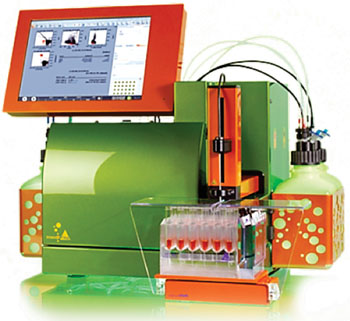Biomarkers Predict HIV Return When Treatment Stopped
By LabMedica International staff writers
Posted on 27 Oct 2015
Treatment of Human Immunodeficiency virus 1 (HIV-1) infection with antiretroviral therapy (ART) in the weeks following transmission may induce a state of “post-treatment control” (PTC) in some patients, in whom viremia remains undetectable when ART is stopped.Posted on 27 Oct 2015
Primary HIV-1 infection (PHI), the period within weeks to months of seroconversion, may provide insights into how this reservoir is activated and whether it can be suppressed, as stopping ART initiated in this early stage has in certain patients been associated with periods of aviremic remission, in some cases for over 10 year.

Image: The Miltenyi MACSQuant Flow Cytometer Analyzer (Photo courtesy of The McGowan Institute).
Scientists at the John Radcliffe Hospital (Oxford, UK) and their collaborators retrospectively analyzed data from a randomized study of patients with primary HIV infection involved in the SPARTAC trial. They compared the T-cells of 154 patients in Europe, Brazil and Australia who had their ART treatment interrupted after 12 or 48 weeks. T-cells play a central role in protecting the immune system. They devised a panel of 18 biomarkers to measure parameters of host immunity and markers of the HIV-1 reservoir.
The investigators used a variety of methods including the measurement of HIV-1 DNA, the quantitation of unspliced cell-associated HIV-1 RNA Transcript which was performed on the Lightcycler 480 (Roche; Basel, Switzerland), quantification of the HIV-1-specific CD8 response was performed by IFN-γ ELISpot analysis (R&D Systems; Minneapolis, MN, USA), fluorescent activated cell sorting run on a MAQSquant flow cytometer (Miltenyi Biotec; San Diego, CA, USA). Interleukin-6 (IL-6) and D-dimer were quantified using commercial assays.
The scientists found that high levels of the T-cell exhaustion markers programmed cell death protein 1 (PD-1), T-cell immunoglobulin domain and mucin domain-3 (Tim-3) and Lymphocyte-activation gene 3 (Lag-3) measured prior to ART strongly predict time to the return of viremia. The data suggests that the size of the reservoir is determined by T-cell-mediated immunity in early HIV-1 infection, reflected in the number of associations between HIV-1 DNA and immune biomarkers at baseline. Once ART is commenced and viral replication is suppressed, the CD4 T-cell count recovers and the HIV-1 reservoir declines.
The authors concluded that participants undergoing treatment interruption after 48 weeks of ART reveals potential new biomarkers that should be considered in larger studies exploring PTC. The correlations between measures of T-cell-mediated immunity and HIV-1 DNA prior to therapy make a case for the reservoir size being determined by T-cell function early in infection. T-cell exhaustion markers may identify those latently infected cells with a higher proclivity to viral transcription. The study was published on October 9, 2015, in the journal Nature Communications.
Related Links:
John Radcliffe Hospital
Roche
Miltenyi Biotec














